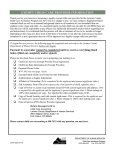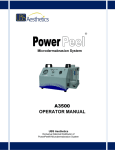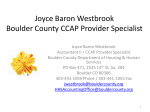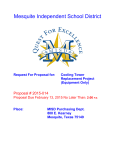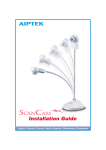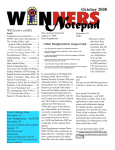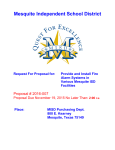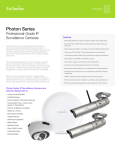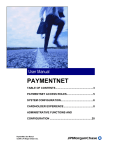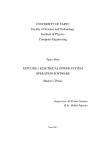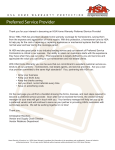Download Forms [packet] specific to Licensed Child Care
Transcript
Colorado Child Care Assistance Program (CCCAP) FISCAL AGREEMENT INSTRUCTIONS Welcome to the Colorado Child Care Assistance Program. We are excited that you are interested in providing quality child care for a program that assists families in meeting their child care expenses. These families need child care in order to move towards self-sufficiency. As a child care provider, you will be working in partnership with Larimer County to assist these families. All providers that provide child care for a family that is receiving CCCAP will be required to sign a Fiscal Agreement. A Fiscal Agreement is a contract between you and Larimer County Department of Human Services. Larimer County has the right to refuse to enter into a fiscal Agreement with a provider or terminate an agreement. The only time a Fiscal Agreement will be changed is when your status changes from unlicensed to licensed or the reverse, when the State authorizes a change in rates or when a provider is closed by State licensing staff. The beginning and ending date of the contract will vary depending on when the county office received the Fiscal Agreement A new Fiscal Agreement will be mailed to you prior to the ending date therefore it is very important you inform the county office of any changes to your address. Since we cannot change your contract it is very important that you read it carefully and provide all information requested. If you agree with the requirements and restrictions that are set forth in the enclosed information, please sign the Fiscal Agreement and return it along with all of the requested information to Larimer County Department of Human Services. Once the signed agreement is received, a pre-printed billing form and a Child Care Certificate will be sent to you. We will not pay any billing requests until the signed Fiscal Agreement and all of the requested information has been returned to the county office and entered into the payment system. You can terminate services with CCCAP children in your care as you would with a private pay family if they are not meeting the rules set forth in their contract with you. Terminating service with one family does not prevent you from being a provider for another family. You are required to notify the child care worker within 30 days if the parent is not keeping current on any parental fees. You cannot charge the CCCAP families the difference between your normal private pay rate and the maximum amount that can be charged to CCCAP families. As a child care provider, you must return the following: ___ FISCAL AGREEMENT (specific to your circumstance: licensed center, licensed home or not licensed) ___ Payment choice letter ___ ACH Form for Colorado Providers (if you chose Direct Deposit as your payment choice) ___ W-9 Form ___ Complete copy of your handbook listing current charge policies on rates, transportation, activity, registration fees, payment policies and days/hours of operation. ___ Point of Service (POS) Device Provider Agreement ___ Copy of POS Certificate ___ Copy of current Childcare License If you have any questions regarding the fiscal agreement or the billing process, please call 498-7623. Return forms to: Child Care Accounting Human Services 2601 Midpoint Drive, Suite 112 Fort Collins, CO 80525 (970) 498-7625 Fax DEPARTMENT OF HUMAN SERVICES LCHS 4204 (9/14) Child Care Assistance Program (970) 498-6300 Page 1 of 17 Intentional Blank Page Page 2 of 17 Licensed Center Provider Fiscal Agreement License/Certificate (Provider ID) Tax ID No. (SSN/FEIN) This Agreement is entered into and between the Larimer County Department of Human Services herein referred to as “Department” and (Provider Name), herein referred to as “provider” who will provide child care at the following address: (Provider Address) This agreement shall be in effect from ______________ to December 31, 2017. Provider Agrees to: 1. Maintain a valid child care license as required by Colorado Statute and conform to all applicable State, Federal Regulations and local law. 2. Report to the Department if the provider’s license has been revoked, suspended, or denied within three (3) calendar days of receiving notification. A recovery will be established of all payments made as of the effective date of closure. 3. Report to the Department any changes in phone number and/or address no less than ten (10) calendar days prior to the change. 4. Allow parents or adult caretakers immediate access to the child(ren) in care. 5. Accept referrals for child care without discrimination with regard to race, color, national origin, age, sex, religion, or physical or mental handicap. 6. Develop an individualized care plan for children with additional child care needs. 7. Provide children with adequate food, shelter, and rest. 8. Maintain as strictly confidential all information concerning children and their families. 9. Protect children from abuse/neglect and report any suspected child abuse and neglect to the Department. 10. Hold the Colorado Department of Human Services (CDHS), the State of Colorado and the County Department of Human Services harmless for any loss or actions caused by the performance of this Agreement. 11. Offer free, age-appropriate alternatives to voluntary activities. 12. Provide child care only at the facility address listed above and/or in Exhibit A, and ensure care is provided only by the person or business listed above. Provide care for children under this agreement only if authorized by the Department in advance. 13. Sign the child care Fiscal Agreement and all other county or state required forms. 14. Notify the Department of a child’s unexplained, frequent, and/or consistent absences within ten (10) calendar days of an established pattern. 15. Collect the full parental fee each month. Parental fees are due to the provider from the parent or adult caretaker on the first of the month. Providers shall report non-payment of parental fees no later than the end of the month following the month the parental fees are due unless county policy requires it earlier. The unpaid parental fees must be reported in writing by FAX, email, mail, or on a manual claim form. 16. Maintain proof of age-appropriate immunizations for the children in the provider’s care based on licensing requirements. Immunization records shall be obtained from parents or adult caretakers either at the time of admission or within thirty (30) calendar days of the date of admission and shall be updated annually. For children whose parents or adult caretakers object to immunizations on religious grounds or for children whose medical condition contraindicates immunization, providers shall maintain a statement in the child's file signed by the parent or adult caretaker stating the reason for not immunizing. 17. Not charge the counties more than the lowest established private pay rates and keep the Department informed of changes in the private pay rates at least ten (10) days prior to the change. Attach a copy of the current policies including rates, transportation, activity, registration fees, payment policies, and all policies distributed to parents or adult caretakers. Allowable rates and other associated charges LCHS 4267 Fiscal Agreement Licensed Centers Revision 10-2014 Updated (10/15) 18. 19. 20. 21. 22. 23. 24. 25. 26. 27. 28. 29. of the current policies including rates, transportation, activity, registration fees, payment policies, and all policies distributed to parents or adult caretakers. Allowable rates and other associated charges shall be in accordance with State Rules for Colorado Child Care Assistance Program. The provider is subject to recovery if the reported private pay rates are lower than the agreed upon county reimbursement rates established in this Fiscal Agreement and/or if providers are paid for care that contradicts provider or county policies. The Department will establish a recovery if the private pay rates are found to be less than the agreed upon rates established by this fiscal agreement. Not charge parents or adult caretakers rates in excess of those agreed upon in the Fiscal Agreement (this includes the agreed upon registration, activity, transportation fees, absences, and holidays as set by Department policy). The rate in the Fiscal Agreement is the maximum allowable rate of reimbursement for the care provided and includes any portion for which the parent or adult caretaker is responsible. Providers may not receive payments for days in which they were not open or available for use. Attend a county face-to-face training before the provider will receive a Point-Of-Service (POS) device, before the fiscal agreement may begin, and before the provider may bill the county for care. The provider may be required to attend additional county face-to-face training at the discretion of the county. Understand this fiscal agreement is effective on or after the date the county receives the signed fiscal agreement from the provider, all additional required forms and documentation, and the provider attended a live face-to-face POS training. Providers will not be reimbursed for any care provided before this fiscal agreement start date and after this fiscal agreement end date. The provider is required to use the POS device to transmit recorded attendance and as the billing mechanism for care provided. Maintain a land-based phone service to ensure the POS terminal is able to transmit attendance information to the Department for payment on a daily basis. The provider shall not hold any parent or adult caretaker responsible for the cost of care if the transactions are not transmitted timely. Storeand-Forward (SAF) transactions must be transmitted timely for payment. Ensure the parent or adult caretaker swipes his/her card to check the child(ren) into and out of care daily for attendance tracking and payment. Missed check-in and check-out swipes may be updated within nine (9) days of the date of service. The Department does not guarantee payment to the Provider if the transaction status on the POS device is “pending,” “denied,” or “not authorized,” or if the attendance is not accurately recorded through the POS device. The parent or adult caretaker shall be responsible for payment and the Department shall not be held liable if the child care is not authorized or the parent or adult caretaker does not accurately record attendance through the device. Only approved attendance transactions, resulting in a daily matched pair of check-ins and check-outs, will be reimbursed by the Department. Train all parents and adult caretaker on the use and importance of the POS device. Contact the XEROX Provider Helpline at 1-877-779-1932 within two business days if the Point of Service (POS) terminal stops working for any reason for troubleshooting or repair. Ensure updates to the POS device are implemented as required by CDHS or the fiscal agreement will be terminated. Follow the instructions included in the POS User Manual. Train all new staff on the proper use and requirements of the POS device. If the provider stops caring for children under the Colorado Child Care Assistance Program they shall contact the Xerox Provider Helpline at 1-877-779-1932 to request a self-address postage paid return label to assist in returning the POS device. If the POS device is not returned within fifteen (15) calendar days and in good condition (allowing for normal wear and tear) to Xerox, the Department will establish a recovery for the POS device which is $365. Maintain sign in/out sheets for children in care. These records shall be maintained for three years plus the current year and are to be made available to the Department upon request. The sign-in/out sheets must include no less than: the date of care; the full name of the child(ren); accurate sign-in time; authorized adult caretaker legible signature for sign-in time; accurate sign-out time; authorized adult caretaker legible signature for sign-out time. Sign-in/out times must be accurate and within five minutes of the time recorded on the POS device. Maintain the original POS receipts for children in their care. These records shall be maintained for three years plus the current year and are to be made available to the Department upon request. Page 4 of 17 LCHS 4267 (10/15) revision 10/2014 2 of 5 30. Manually bill the Department for authorized services, based on county payroll policies, not reimbursed automatically based on approved POS transactions. The provider shall provide sign in/out sheets and all other requested information based on county policy to support requests for manual payment. Counties may impose additional requirement regarding manual claims. The provider forfeits payment for services if the original manual billing form is received by the county more than sixty (60) calendar days following the end of the month of care. The provider forfeits payment for services billed manually if the care could have been paid through the automated payment process. 31. Never keep in their possession (whether at the facility or in any other place) a client’s CCAP Card. 32. Understand that if the provider commits fraud or an intentional program violation the provider will be subject to disqualification from the Colorado Child Care Assistance Program (CCCAP) as a provider for 12 months for the first offense; 24 months for the second offense and permanently for the third offense. Violations of this nature will be reported to CDHS licensing staff. 33. Grant the Department and/or child care licensing the authority to inspect the provider's facility for the presence of CCAP Cards or any other suspicious billing information. Upon discovery of these materials the provider understands either of these entities have the right to seize these materials including the CCAP Cards and/or POS Device. 34. Return any overpayment. All overpayments will be recovered including, but not limited to, inaccurate or fraudulent billing. If at the time any overpayment is established while your fiscal agreement is active, the amount of the overpayment will be deducted beginning with the next child care payment and every payment thereafter until the overpayment is paid in full, unless negotiated otherwise by the county through a signed repayment agreement. The county shall collect the overpayment in accordance with standard collection procedures which may include State Income Tax intercept if your fiscal agreement is inactive. Fraudulent billing will be prosecuted. 35. Be paid the rates agreed upon in the attached Fiscal Agreement Rate Information. Payments are based on the lesser of the authorized or attended hours. 36. Up to $465 of registration, activity and transportation fees, as well as six paid holidays (New Years Day, Memorial Day, Fourth of July, Labor Day, Thanksgiving Day and Christmas Day) and nine absences per year are included in the CCAP daily rates paid to licensed child care providers. You may not charge the adult caretaker ANY additional annual registration, activity or transportation fees. You may ONLY charge for additional holidays or absences if it exceeds the number paid by the County. 37. This agreement may be cancelled without notice by the department if there are child health or safety concerns involving the provider or a resident in the provider’s home. Provider Rights: 1. When a provider contends that the county has not made adequate payment based on program rules for care provided, the provider has the right to an informal conference with county staff pursuant to 9 CCR 2503-1 at Section 3.910, (D). Providers may request a conference in writing within 15 days of the date of the action. This request should be addressed to the county director of the county Department of Social/Human services responsible for the action. Provider may request that State CCCAP staff participate in the conference. That participation may be by telephone conference. The conference shall be held within two weeks of the date the request for a conference is received by the county. The purpose of the conference is limited to discussion about the payments in dispute and the relevant rules regarding payment. The final decision of the county shall be mailed to the provider within 15 days of the conference date. 2. A provider may request an informal conference if s/he disputes the termination of a Fiscal Agreement pursuant to 9 CCR 2503-1 at Section 3.912,4. Page 5 of 17 LCHS 4267 (10/15) revision 10/2014 3 of 5 Providers may request a conference in writing within 15 days of the date of the action. This request should be addressed to the county director of the county Department of Social/Human services responsible for the action. The conference shall be held within two weeks of the date the request for a conference is received by the county. The purpose of the conference is limited to discussion about the termination of the fiscal agreement pursuant to 9 CCR 2503-1 at Section 3.906, (D). The final decision of the county shall be mailed to the provider within 15 days of the conference date. Department Agrees to: 1. Provide face-to-face training to the provider on how to use the Point of Service (POS) device prior to entering into a Fiscal Agreement with the provider. 2. Enter the Fiscal Agreement into the Childcare Automated Tracking System (CHATS) within five (5) business days of receipt of the completed Fiscal Agreement and all supporting documentation. 3. Determine client's eligibility for child care services within fifteen (15) days of receiving the complete application packet including verification. 4. Send Child Care Authorization Notices to the provider within seven (7) business days of the Department's initial approval or prior to making any changes in eligibility for each child such as parental fees, authorized amount of care, added or deleted children, and/or any other changes to child care arrangements. 5. Reimburse the provider for authorized, attended, and properly recorded and transmitted child care in accordance with Colorado Child Care Assistance Program rules. Payment to the licensed provider is the total cost of the lesser of authorized and attended care based on rates set by this Agreement minus the parental fee (if applicable). This Agreement may be terminated by either party by giving the other party eleven (11) calendar days notice. This Agreement may be terminated without advance notice if a child's health or safety is endangered; if the provider is under a negative licensing action; if the Department has concerns involving the provider, an employee, or a resident in the provider's home; or if the Department or CDHS verifies the provider possesses any CCAP card(s). By signing this Agreement, the provider acknowledges receipt of information regarding the rules and policies of the Colorado Child Care Assistance Program. The effective date of this contract is no earlier than the date that the county receives and signs the Fiscal Agreement. The provider shall receive a copy of the signed Fiscal Agreement. Page 6 of 17 LCHS 4267 (10/15) revision 10/2014 4 of 5 CHILD CARE DIRECTOR Print Name CHILD CARE OWNER OR DESIGNEE Date Print Name Signature Signature Mailing Address Mailing Address City, State Zip Phone Date City State Zip Phone DEPARTMENT OF SOCIAL/HUMAN SERVICES Marsha Ellis Authorized Representative (Print Name) Date Signature 1501 Blue Spruce Mailing Address Fort Collins, CO 80524 970-498-6300 City, State, Zip Phone Page 7 of 17 LCHS 4267 (10/15) revision 10/2014 5 of 5 Intentional Blank Page Page 8 of 17 W-9 Form (Rev. August 2013) Department of the Treasury Internal Revenue Service Request for Taxpayer Identification Number and Certification Give Form to the requester. Do not send to the IRS. Print or type See Specific Instructions on page 2. Name (as shown on your income tax return) Business name/disregarded entity name, if different from above Exemptions (see instructions): Check appropriate box for federal tax classification: Individual/sole proprietor C Corporation S Corporation Partnership Trust/estate Exempt payee code (if any) Limited liability company. Enter the tax classification (C=C corporation, S=S corporation, P=partnership) ▶ Other (see instructions) ▶ Address (number, street, and apt. or suite no.) Exemption from FATCA reporting code (if any) Requester’s name and address (optional) City, state, and ZIP code List account number(s) here (optional) Part I Taxpayer Identification Number (TIN) Enter your TIN in the appropriate box. The TIN provided must match the name given on the “Name” line to avoid backup withholding. For individuals, this is your social security number (SSN). However, for a resident alien, sole proprietor, or disregarded entity, see the Part I instructions on page 3. For other entities, it is your employer identification number (EIN). If you do not have a number, see How to get a TIN on page 3. Social security number Note. If the account is in more than one name, see the chart on page 4 for guidelines on whose number to enter. Employer identification number Part II – – – Certification Under penalties of perjury, I certify that: 1. The number shown on this form is my correct taxpayer identification number (or I am waiting for a number to be issued to me), and 2. I am not subject to backup withholding because: (a) I am exempt from backup withholding, or (b) I have not been notified by the Internal Revenue Service (IRS) that I am subject to backup withholding as a result of a failure to report all interest or dividends, or (c) the IRS has notified me that I am no longer subject to backup withholding, and 3. I am a U.S. citizen or other U.S. person (defined below), and 4. The FATCA code(s) entered on this form (if any) indicating that I am exempt from FATCA reporting is correct. Certification instructions. You must cross out item 2 above if you have been notified by the IRS that you are currently subject to backup withholding because you have failed to report all interest and dividends on your tax return. For real estate transactions, item 2 does not apply. For mortgage interest paid, acquisition or abandonment of secured property, cancellation of debt, contributions to an individual retirement arrangement (IRA), and generally, payments other than interest and dividends, you are not required to sign the certification, but you must provide your correct TIN. See the instructions on page 3. Sign Here Signature of U.S. person ▶ Date ▶ General Instructions withholding tax on foreign partners’ share of effectively connected income, and Section references are to the Internal Revenue Code unless otherwise noted. Future developments. The IRS has created a page on IRS.gov for information about Form W-9, at www.irs.gov/w9. Information about any future developments affecting Form W-9 (such as legislation enacted after we release it) will be posted on that page. Purpose of Form A person who is required to file an information return with the IRS must obtain your correct taxpayer identification number (TIN) to report, for example, income paid to you, payments made to you in settlement of payment card and third party network transactions, real estate transactions, mortgage interest you paid, acquisition or abandonment of secured property, cancellation of debt, or contributions you made to an IRA. Use Form W-9 only if you are a U.S. person (including a resident alien), to provide your correct TIN to the person requesting it (the requester) and, when applicable, to: 1. Certify that the TIN you are giving is correct (or you are waiting for a number to be issued), 2. Certify that you are not subject to backup withholding, or 3. Claim exemption from backup withholding if you are a U.S. exempt payee. If applicable, you are also certifying that as a U.S. person, your allocable share of any partnership income from a U.S. trade or business is not subject to the 4. Certify that FATCA code(s) entered on this form (if any) indicating that you are exempt from the FATCA reporting, is correct. Note. If you are a U.S. person and a requester gives you a form other than Form W-9 to request your TIN, you must use the requester’s form if it is substantially similar to this Form W-9. Definition of a U.S. person. For federal tax purposes, you are considered a U.S. person if you are: • An individual who is a U.S. citizen or U.S. resident alien, • A partnership, corporation, company, or association created or organized in the United States or under the laws of the United States, • An estate (other than a foreign estate), or • A domestic trust (as defined in Regulations section 301.7701-7). Special rules for partnerships. Partnerships that conduct a trade or business in the United States are generally required to pay a withholding tax under section 1446 on any foreign partners’ share of effectively connected taxable income from such business. Further, in certain cases where a Form W-9 has not been received, the rules under section 1446 require a partnership to presume that a partner is a foreign person, and pay the section 1446 withholding tax. Therefore, if you are a U.S. person that is a partner in a partnership conducting a trade or business in the United States, provide Form W-9 to the partnership to establish your U.S. status and avoid section 1446 withholding on your share of partnership income. Page 9 of 17 Cat. No. 10231X Form W-9 (Rev. 8-2013) Page 2 Form W-9 (Rev. 8-2013) In the cases below, the following person must give Form W-9 to the partnership for purposes of establishing its U.S. status and avoiding withholding on its allocable share of net income from the partnership conducting a trade or business in the United States: Updating Your Information • In the case of a grantor trust with a U.S. grantor or other U.S. owner, generally, the U.S. grantor or other U.S. owner of the grantor trust and not the trust, and You must provide updated information to any person to whom you claimed to be an exempt payee if you are no longer an exempt payee and anticipate receiving reportable payments in the future from this person. For example, you may need to provide updated information if you are a C corporation that elects to be an S corporation, or if you no longer are tax exempt. In addition, you must furnish a new Form W-9 if the name or TIN changes for the account, for example, if the grantor of a grantor trust dies. • In the case of a U.S. trust (other than a grantor trust), the U.S. trust (other than a grantor trust) and not the beneficiaries of the trust. Penalties Foreign person. If you are a foreign person or the U.S. branch of a foreign bank that has elected to be treated as a U.S. person, do not use Form W-9. Instead, use the appropriate Form W-8 or Form 8233 (see Publication 515, Withholding of Tax on Nonresident Aliens and Foreign Entities). Failure to furnish TIN. If you fail to furnish your correct TIN to a requester, you are subject to a penalty of $50 for each such failure unless your failure is due to reasonable cause and not to willful neglect. • In the case of a disregarded entity with a U.S. owner, the U.S. owner of the disregarded entity and not the entity, Nonresident alien who becomes a resident alien. Generally, only a nonresident alien individual may use the terms of a tax treaty to reduce or eliminate U.S. tax on certain types of income. However, most tax treaties contain a provision known as a “saving clause.” Exceptions specified in the saving clause may permit an exemption from tax to continue for certain types of income even after the payee has otherwise become a U.S. resident alien for tax purposes. If you are a U.S. resident alien who is relying on an exception contained in the saving clause of a tax treaty to claim an exemption from U.S. tax on certain types of income, you must attach a statement to Form W-9 that specifies the following five items: 1. The treaty country. Generally, this must be the same treaty under which you claimed exemption from tax as a nonresident alien. 2. The treaty article addressing the income. 3. The article number (or location) in the tax treaty that contains the saving clause and its exceptions. 4. The type and amount of income that qualifies for the exemption from tax. 5. Sufficient facts to justify the exemption from tax under the terms of the treaty article. Example. Article 20 of the U.S.-China income tax treaty allows an exemption from tax for scholarship income received by a Chinese student temporarily present in the United States. Under U.S. law, this student will become a resident alien for tax purposes if his or her stay in the United States exceeds 5 calendar years. However, paragraph 2 of the first Protocol to the U.S.-China treaty (dated April 30, 1984) allows the provisions of Article 20 to continue to apply even after the Chinese student becomes a resident alien of the United States. A Chinese student who qualifies for this exception (under paragraph 2 of the first protocol) and is relying on this exception to claim an exemption from tax on his or her scholarship or fellowship income would attach to Form W-9 a statement that includes the information described above to support that exemption. If you are a nonresident alien or a foreign entity, give the requester the appropriate completed Form W-8 or Form 8233. What is backup withholding? Persons making certain payments to you must under certain conditions withhold and pay to the IRS a percentage of such payments. This is called “backup withholding.” Payments that may be subject to backup withholding include interest, tax-exempt interest, dividends, broker and barter exchange transactions, rents, royalties, nonemployee pay, payments made in settlement of payment card and third party network transactions, and certain payments from fishing boat operators. Real estate transactions are not subject to backup withholding. You will not be subject to backup withholding on payments you receive if you give the requester your correct TIN, make the proper certifications, and report all your taxable interest and dividends on your tax return. Payments you receive will be subject to backup withholding if: 1. You do not furnish your TIN to the requester, 2. You do not certify your TIN when required (see the Part II instructions on page 3 for details), 3. The IRS tells the requester that you furnished an incorrect TIN, 4. The IRS tells you that you are subject to backup withholding because you did not report all your interest and dividends on your tax return (for reportable interest and dividends only), or 5. You do not certify to the requester that you are not subject to backup withholding under 4 above (for reportable interest and dividend accounts opened after 1983 only). Certain payees and payments are exempt from backup withholding. See Exempt payee code on page 3 and the separate Instructions for the Requester of Form W-9 for more information. Also see Special rules for partnerships on page 1. What is FATCA reporting? The Foreign Account Tax Compliance Act (FATCA) requires a participating foreign financial institution to report all United States account holders that are specified United States persons. Certain payees are exempt from FATCA reporting. See Exemption from FATCA reporting code on page 3 and the Instructions for the Requester of Form W-9 for more information. Civil penalty for false information with respect to withholding. If you make a false statement with no reasonable basis that results in no backup withholding, you are subject to a $500 penalty. Criminal penalty for falsifying information. Willfully falsifying certifications or affirmations may subject you to criminal penalties including fines and/or imprisonment. Misuse of TINs. If the requester discloses or uses TINs in violation of federal law, the requester may be subject to civil and criminal penalties. Specific Instructions Name If you are an individual, you must generally enter the name shown on your income tax return. However, if you have changed your last name, for instance, due to marriage without informing the Social Security Administration of the name change, enter your first name, the last name shown on your social security card, and your new last name. If the account is in joint names, list first, and then circle, the name of the person or entity whose number you entered in Part I of the form. Sole proprietor. Enter your individual name as shown on your income tax return on the “Name” line. You may enter your business, trade, or “doing business as (DBA)” name on the “Business name/disregarded entity name” line. Partnership, C Corporation, or S Corporation. Enter the entity's name on the “Name” line and any business, trade, or “doing business as (DBA) name” on the “Business name/disregarded entity name” line. Disregarded entity. For U.S. federal tax purposes, an entity that is disregarded as an entity separate from its owner is treated as a “disregarded entity.” See Regulation section 301.7701-2(c)(2)(iii). Enter the owner's name on the “Name” line. The name of the entity entered on the “Name” line should never be a disregarded entity. The name on the “Name” line must be the name shown on the income tax return on which the income should be reported. For example, if a foreign LLC that is treated as a disregarded entity for U.S. federal tax purposes has a single owner that is a U.S. person, the U.S. owner's name is required to be provided on the “Name” line. If the direct owner of the entity is also a disregarded entity, enter the first owner that is not disregarded for federal tax purposes. Enter the disregarded entity's name on the “Business name/disregarded entity name” line. If the owner of the disregarded entity is a foreign person, the owner must complete an appropriate Form W-8 instead of a Form W-9. This is the case even if the foreign person has a U.S. TIN. Note. Check the appropriate box for the U.S. federal tax classification of the person whose name is entered on the “Name” line (Individual/sole proprietor, Partnership, C Corporation, S Corporation, Trust/estate). Limited Liability Company (LLC). If the person identified on the “Name” line is an LLC, check the “Limited liability company” box only and enter the appropriate code for the U.S. federal tax classification in the space provided. If you are an LLC that is treated as a partnership for U.S. federal tax purposes, enter “P” for partnership. If you are an LLC that has filed a Form 8832 or a Form 2553 to be taxed as a corporation, enter “C” for C corporation or “S” for S corporation, as appropriate. If you are an LLC that is disregarded as an entity separate from its owner under Regulation section 301.7701-3 (except for employment and excise tax), do not check the LLC box unless the owner of the LLC (required to be identified on the “Name” line) is another LLC that is not disregarded for U.S. federal tax purposes. If the LLC is disregarded as an entity separate from its owner, enter the appropriate tax classification of the owner identified on the “Name” line. Other entities. Enter your business name as shown on required U.S. federal tax documents on the “Name” line. This name should match the name shown on the charter or other legal document creating the entity. You may enter any business, trade, or DBA name on the “Business name/disregarded entity name” line. Exemptions If you are exempt from backup withholding and/or FATCA reporting, enter in the Exemptions box, any code(s) that may apply to you. See Exempt payee code and Exemption from FATCA reporting code on page 3. Page 10 of 17 Page 3 Form W-9 (Rev. 8-2013) Exempt payee code. Generally, individuals (including sole proprietors) are not exempt from backup withholding. Corporations are exempt from backup withholding for certain payments, such as interest and dividends. Corporations are not exempt from backup withholding for payments made in settlement of payment card or third party network transactions. Note. If you are exempt from backup withholding, you should still complete this form to avoid possible erroneous backup withholding. The following codes identify payees that are exempt from backup withholding: 1—An organization exempt from tax under section 501(a), any IRA, or a custodial account under section 403(b)(7) if the account satisfies the requirements of section 401(f)(2) 2—The United States or any of its agencies or instrumentalities 3—A state, the District of Columbia, a possession of the United States, or any of their political subdivisions or instrumentalities 4—A foreign government or any of its political subdivisions, agencies, or instrumentalities G—A real estate investment trust H—A regulated investment company as defined in section 851 or an entity registered at all times during the tax year under the Investment Company Act of 1940 I—A common trust fund as defined in section 584(a) J—A bank as defined in section 581 K—A broker L—A trust exempt from tax under section 664 or described in section 4947(a)(1) M—A tax exempt trust under a section 403(b) plan or section 457(g) plan Part I. Taxpayer Identification Number (TIN) Enter your TIN in the appropriate box. If you are a resident alien and you do not have and are not eligible to get an SSN, your TIN is your IRS individual taxpayer identification number (ITIN). Enter it in the social security number box. If you do not have an ITIN, see How to get a TIN below. If you are a sole proprietor and you have an EIN, you may enter either your SSN or EIN. However, the IRS prefers that you use your SSN. 5—A corporation 6—A dealer in securities or commodities required to register in the United States, the District of Columbia, or a possession of the United States If you are a single-member LLC that is disregarded as an entity separate from its owner (see Limited Liability Company (LLC) on page 2), enter the owner’s SSN (or EIN, if the owner has one). Do not enter the disregarded entity’s EIN. If the LLC is classified as a corporation or partnership, enter the entity’s EIN. 7—A futures commission merchant registered with the Commodity Futures Trading Commission 8—A real estate investment trust Note. See the chart on page 4 for further clarification of name and TIN combinations. 9—An entity registered at all times during the tax year under the Investment Company Act of 1940 10—A common trust fund operated by a bank under section 584(a) 11—A financial institution 12—A middleman known in the investment community as a nominee or custodian 13—A trust exempt from tax under section 664 or described in section 4947 The following chart shows types of payments that may be exempt from backup withholding. The chart applies to the exempt payees listed above, 1 through 13. IF the payment is for . . . THEN the payment is exempt for . . . Interest and dividend payments All exempt payees except for 7 Broker transactions Exempt payees 1 through 4 and 6 through 11 and all C corporations. S corporations must not enter an exempt payee code because they are exempt only for sales of noncovered securities acquired prior to 2012. How to get a TIN. If you do not have a TIN, apply for one immediately. To apply for an SSN, get Form SS-5, Application for a Social Security Card, from your local Social Security Administration office or get this form online at www.ssa.gov. You may also get this form by calling 1-800-772-1213. Use Form W-7, Application for IRS Individual Taxpayer Identification Number, to apply for an ITIN, or Form SS-4, Application for Employer Identification Number, to apply for an EIN. You can apply for an EIN online by accessing the IRS website at www.irs.gov/businesses and clicking on Employer Identification Number (EIN) under Starting a Business. You can get Forms W-7 and SS-4 from the IRS by visiting IRS.gov or by calling 1-800TAX-FORM (1-800-829-3676). If you are asked to complete Form W-9 but do not have a TIN, apply for a TIN and write “Applied For” in the space for the TIN, sign and date the form, and give it to the requester. For interest and dividend payments, and certain payments made with respect to readily tradable instruments, generally you will have 60 days to get a TIN and give it to the requester before you are subject to backup withholding on payments. The 60-day rule does not apply to other types of payments. You will be subject to backup withholding on all such payments until you provide your TIN to the requester. Note. Entering “Applied For” means that you have already applied for a TIN or that you intend to apply for one soon. Caution: A disregarded U.S. entity that has a foreign owner must use the appropriate Form W-8. Barter exchange transactions and patronage dividends Exempt payees 1 through 4 Payments over $600 required to be 1 reported and direct sales over $5,000 Generally, exempt payees 2 1 through 5 To establish to the withholding agent that you are a U.S. person, or resident alien, sign Form W-9. You may be requested to sign by the withholding agent even if items 1, 4, or 5 below indicate otherwise. Payments made in settlement of payment card or third party network transactions Exempt payees 1 through 4 For a joint account, only the person whose TIN is shown in Part I should sign (when required). In the case of a disregarded entity, the person identified on the “Name” line must sign. Exempt payees, see Exempt payee code earlier. Part II. Certification 1 See Form 1099-MISC, Miscellaneous Income, and its instructions. 2 However, the following payments made to a corporation and reportable on Form 1099-MISC are not exempt from backup withholding: medical and health care payments, attorneys' fees, gross proceeds paid to an attorney, and payments for services paid by a federal executive agency. Exemption from FATCA reporting code. The following codes identify payees that are exempt from reporting under FATCA. These codes apply to persons submitting this form for accounts maintained outside of the United States by certain foreign financial institutions. Therefore, if you are only submitting this form for an account you hold in the United States, you may leave this field blank. Consult with the person requesting this form if you are uncertain if the financial institution is subject to these requirements. A—An organization exempt from tax under section 501(a) or any individual retirement plan as defined in section 7701(a)(37) B—The United States or any of its agencies or instrumentalities C—A state, the District of Columbia, a possession of the United States, or any of their political subdivisions or instrumentalities D—A corporation the stock of which is regularly traded on one or more established securities markets, as described in Reg. section 1.1472-1(c)(1)(i) E—A corporation that is a member of the same expanded affiliated group as a corporation described in Reg. section 1.1472-1(c)(1)(i) F—A dealer in securities, commodities, or derivative financial instruments (including notional principal contracts, futures, forwards, and options) that is registered as such under the laws of the United States or any state Signature requirements. Complete the certification as indicated in items 1 through 5 below. 1. Interest, dividend, and barter exchange accounts opened before 1984 and broker accounts considered active during 1983. You must give your correct TIN, but you do not have to sign the certification. 2. Interest, dividend, broker, and barter exchange accounts opened after 1983 and broker accounts considered inactive during 1983. You must sign the certification or backup withholding will apply. If you are subject to backup withholding and you are merely providing your correct TIN to the requester, you must cross out item 2 in the certification before signing the form. 3. Real estate transactions. You must sign the certification. You may cross out item 2 of the certification. 4. Other payments. You must give your correct TIN, but you do not have to sign the certification unless you have been notified that you have previously given an incorrect TIN. “Other payments” include payments made in the course of the requester’s trade or business for rents, royalties, goods (other than bills for merchandise), medical and health care services (including payments to corporations), payments to a nonemployee for services, payments made in settlement of payment card and third party network transactions, payments to certain fishing boat crew members and fishermen, and gross proceeds paid to attorneys (including payments to corporations). 5. Mortgage interest paid by you, acquisition or abandonment of secured property, cancellation of debt, qualified tuition program payments (under section 529), IRA, Coverdell ESA, Archer MSA or HSA contributions or distributions, and pension distributions. You must give your correct TIN, but you do not have to sign the certification. Page 11 of 17 Page 4 Form W-9 (Rev. 8-2013) What Name and Number To Give the Requester For this type of account: 1. Individual 2. Two or more individuals (joint account) The individual The actual owner of the account or, if combined funds, the first 1 individual on the account 3. Custodian account of a minor (Uniform Gift to Minors Act) The minor 4. a. The usual revocable savings trust (grantor is also trustee) b. So-called trust account that is not a legal or valid trust under state law 5. Sole proprietorship or disregarded entity owned by an individual 6. Grantor trust filing under Optional Form 1099 Filing Method 1 (see Regulation section 1.671-4(b)(2)(i)(A)) 2 The actual owner The owner • Be careful when choosing a tax preparer. If your tax records are affected by identity theft and you receive a notice from the IRS, respond right away to the name and phone number printed on the IRS notice or letter. If your tax records are not currently affected by identity theft but you think you are at risk due to a lost or stolen purse or wallet, questionable credit card activity or credit report, contact the IRS Identity Theft Hotline at 1-800-908-4490 or submit Form 14039. The grantor* Give name and EIN of: For more information, see Publication 4535, Identity Theft Prevention and Victim Assistance. The owner Victims of identity theft who are experiencing economic harm or a system problem, or are seeking help in resolving tax problems that have not been resolved through normal channels, may be eligible for Taxpayer Advocate Service (TAS) assistance. You can reach TAS by calling the TAS toll-free case intake line at 1-877-777-4778 or TTY/TDD 1-800-829-4059. 4 The corporation 11. Partnership or multi-member LLC 12. A broker or registered nominee The partnership The broker or nominee 13. Account with the Department of Agriculture in the name of a public entity (such as a state or local government, school district, or prison) that receives agricultural program payments The public entity 14. Grantor trust filing under the Form 1041 Filing Method or the Optional Form 1099 Filing Method 2 (see Regulation section 1.671-4(b)(2)(i)(B)) The trust 3 • Ensure your employer is protecting your SSN, and 1 9. Corporation or LLC electing corporate status on Form 8832 or Form 2553 10. Association, club, religious, charitable, educational, or other tax-exempt organization 2 Identity theft occurs when someone uses your personal information such as your name, social security number (SSN), or other identifying information, without your permission, to commit fraud or other crimes. An identity thief may use your SSN to get a job or may file a tax return using your SSN to receive a refund. • Protect your SSN, 1 3 Legal entity Secure Your Tax Records from Identity Theft To reduce your risk: The grantor-trustee For this type of account: 7. Disregarded entity not owned by an individual 8. A valid trust, estate, or pension trust 1 Note. If no name is circled when more than one name is listed, the number will be considered to be that of the first name listed. Give name and SSN of: Protect yourself from suspicious emails or phishing schemes. Phishing is the creation and use of email and websites designed to mimic legitimate business emails and websites. The most common act is sending an email to a user falsely claiming to be an established legitimate enterprise in an attempt to scam the user into surrendering private information that will be used for identity theft. The organization The IRS does not initiate contacts with taxpayers via emails. Also, the IRS does not request personal detailed information through email or ask taxpayers for the PIN numbers, passwords, or similar secret access information for their credit card, bank, or other financial accounts. If you receive an unsolicited email claiming to be from the IRS, forward this message to [email protected]. You may also report misuse of the IRS name, logo, or other IRS property to the Treasury Inspector General for Tax Administration at 1-800-366-4484. You can forward suspicious emails to the Federal Trade Commission at: [email protected] or contact them at www.ftc.gov/idtheft or 1-877IDTHEFT (1-877-438-4338). Visit IRS.gov to learn more about identity theft and how to reduce your risk. List first and circle the name of the person whose number you furnish. If only one person on a joint account has an SSN, that person’s number must be furnished. Circle the minor’s name and furnish the minor’s SSN. You must show your individual name and you may also enter your business or “DBA” name on the “Business name/disregarded entity” name line. You may use either your SSN or EIN (if you have one), but the IRS encourages you to use your SSN. 4 List first and circle the name of the trust, estate, or pension trust. (Do not furnish the TIN of the personal representative or trustee unless the legal entity itself is not designated in the account title.) Also see Special rules for partnerships on page 1. *Note. Grantor also must provide a Form W-9 to trustee of trust. Privacy Act Notice Section 6109 of the Internal Revenue Code requires you to provide your correct TIN to persons (including federal agencies) who are required to file information returns with the IRS to report interest, dividends, or certain other income paid to you; mortgage interest you paid; the acquisition or abandonment of secured property; the cancellation of debt; or contributions you made to an IRA, Archer MSA, or HSA. The person collecting this form uses the information on the form to file information returns with the IRS, reporting the above information. Routine uses of this information include giving it to the Department of Justice for civil and criminal litigation and to cities, states, the District of Columbia, and U.S. commonwealths and possessions for use in administering their laws. The information also may be disclosed to other countries under a treaty, to federal and state agencies to enforce civil and criminal laws, or to federal law enforcement and intelligence agencies to combat terrorism. You must provide your TIN whether or not you are required to file a tax return. Under section 3406, payers must generally withhold a percentage of taxable interest, dividend, and certain other payments to a payee who does not give a TIN to the payer. Certain penalties may also apply for providing false or fraudulent information. Page 12 of 17 DEPARTMENT OF HUMAN SERVICES Child Care Assistance Program 1501 Blue Spruce Drive Fort Collins, CO 80524 (970) 498-6300 Fax: (970) 498-7987 Dear Child Care Provider, You have a choice of how you will receive your child care payment. Below are the choices you have and a little information about each choice. Direct Deposit • Your payment will go directly into your checking or savings account. The first month may need to be on a Colorado Quest Card. The following month, your payment will go to your bank account. With Direct Deposit your payment should be available to you the Wednesday or Thursday after our payroll closes. Colorado EBT – Quest Card • The Quest Card is issued to you and your childcare payments are put on the card. The card is somewhat like a debit card. You can access your money at grocery stores, other retailers and ATM’s (remember ATM’s do charge a fee, which would reduce your amount). You will have access to your money on the Monday after our payroll closes. This is the fastest way to get your payment. You will need to come into our Fort Collins office to get your card and to select your Personal Identification Number (PIN). If you already have an EBT Quest Card, your childcare payments can be added to your existing card. PLEASE SELECT ONLY ONE OF THE FOLLOWING CHOICES: I currently receive direct deposit and would like to continue. Direct Deposit into Checking or Savings account (please fill out the form “ACH FORM FOR COLORADO PROVIDERS, For Direct Deposit Payments” & return it with your packet. Check here if you already have an EBT Card and would like your childcare payments added on to your card. New Colorado EBT Quest Card (Contact Gail Graham at 498-7623) Pick up your Colorado EBT Quest Card at: Larimer County Department of Human Services 1501 Blue Spruce Drive Fort Collins, CO 80524 * Bring a picture I.D. _____________________________________ Provider Signature _________________________________ Date ______________________________________________ Social Security Number or Provider ID# LCHS 4220 (07/10) Page 13 of 17 Intentional Blank Page Page 14 of 17 ACH FORM FOR COLORADO PROVIDERS FOR DIRECT DEPOSIT PAYMENTS TO PROVIDERS I (we) hereby authorize J.P. Morgan Electronic Financial Services, Inc. (JPMorgan EFS), as designated agent for the Colorado Department of Human Services (CDHS), to initiate credit entries, and if necessary, reverse any incorrect EFT credit entries made in error due to the bank account indicated below, in accordance with standard banking procedures, for payments related to the Colorado Electronic Benefits Transfer (EBT) program. County Use Only: - PROVIDER NUMBER REQUIRED Child Care (CC) Foster/Adoptive (CW) Colo. Works, TANF, COIN (9digit) LEAP (LE) Nursing Home (NH) CORE, CASE (CW3) Name of County Staff completing this section: Phone of County Staff (including Area Code) Your Name: Address: City, State, Zip: Telephone # (including area code): Federal E.I.N. #: OR ( ) - - - Social Security #: - - CHECK HERE IF THIS IS A REQUEST TO CHANGE BANKING INFO PREVIOUSLY SUBMITTED: If a change of banking information, what is the effective date of this change? TYPE OF ACCOUNT: (Please check only one): Checking (attach voided check) Savings (attach voided deposit slip) Account #: Name of Bank: Transit/Routing #: Telephone # for Bank: (Please check with your bank to ensure this number is correct for direct deposit.) ( ) - - This agreement is to remain in full force and effect until (JPMorgan EFS), as designated agent for CDHS, has received written notofication from the vendor/provider of its termination in such time and manner to afford JPMorgan EFS a reasonable opportunity to act on it. It is the responsibility of the vendor/provider to fill out and submit a new Authorization Agreement to CDHS if the vendor/provider changes banks or accounts. Provider Signature Please return this form to: LCHS 3510 (2/15) Date Accounting/Child Care Larimer County DHS 2601 Midpoint Drive, Suite 112 Fort Collins, Colorado 80525 Page 15 of 17 Intentional Blank Page Page 16 of 17 Provider Information Bulletin To: CCAP Providers From: CHATS Implementation Team Date: July 1, 2010 Re: Provider Training and Registration Child Care Assistance Program Mandatory Provider Training and Class Registration Information The new Childcare Assistance Tracking System or CHATS has been implemented in five pilot counties in the State which include; El Paso, Lincoln, Larimer, Summit and Weld counties. This is the system that is used to track attendance that generates payment to child care providers that accommodate the State’s Child Care Assistance Program, CCAP. It was also introduced that the State is requiring all providers to attend a Provider Training Workshop. Licensed Child Care Centers, Licensed Family Child Care Homes, and Qualified Family Child Care Homes You should already be working with your County on a new Fiscal Agreement and Point-of-Service (POS) Agreement in order to remain a CCAP Provider. ***THIS IS A REQUIREMENT IN ORDER TO BE CONTRACTED WITH LARIMER COUNTY*** To register for the classes below, please contact the registration person listed below. Providers may attend any of the trainings offered. If you have any questions about training, Fiscal or POS Agreements or general questions about the new system, please email [email protected] Thank you, Larimer County CCAP Date & Time First Wednesday of each month. 1:30 p.m. LCHS 5566 (04/13) Location Call for Registration Room 124 2573 Midpoint Drive, Suite 108 Fort Collins, CO 80525 Page 17 of 17 Gail (970) 498-7623 or Karen (970) 498-7627


















